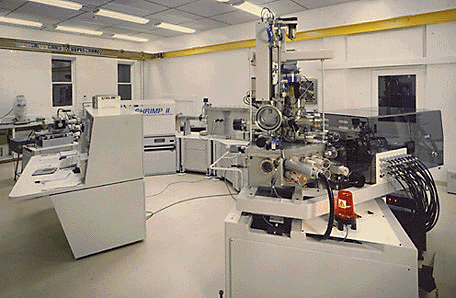|
Instrument Database:
Australian Scientific Instruments Pty. Ltd. - SHRIMP II
| |
|

|
| |
|
| |
|
| Year of introduction |
|
| Status |
historical ( out of sale ) |
| Company |
Australian Scientific Instruments Pty. Ltd.
|
| Categories |
Mass spectrometer: SIMS/SNMS
|
|
The operating principle of SHRIMP is quite simple. A high-energy (10kV) beam of ions (usually O2-) is focussed onto a small area (<30 µm diameter) on the surface of the target. The ion bombardment erodes (sputters) atoms and molecules from the target, some of which are themselves ionised. These secondary ions are gathered using electrostatic lenses and transfered to a mass spectrometer, by which they are separated according to their relative masses. A limiting factor in the accuracy of all ion probe analyses is the mass spectrometer's ability to distinguish between (resolve) secondary ions of atoms and molecules that are extremely similar in mass (isobars).
In the secondary ion spectra of complex compounds, isobars with fractional mass differences of <3 x 10-4 are common. The high mass resolution of SHRIMP is achieved by the use of double-focussing mass spectrometer (simultaneous energy and mass refocussing) with a very large turning radius (magnet radius 1 m, electrostatic analyser radius 1.27 m) The resulting instrument has a beam line over 7 m long and weighs more than 12 tonnes. The SHRIMP II Sensitive High Resolution Ion Micro Probe, developed, manufactured, and marketed by Australian Scientific Instruments (ASI), is a fully commercial version of an instrument originally designed for geological research purposes and constructed by the Research School of Earth Sciences (RSES) at the Australian National University (ANU).
The SHRIMP II ion microprobe is a high precision scientific instrument in the broad category of Secondary Ion Mass Spectrometers (SIMS). Ion microprobes make in situ isotopic and chemical 'surface' analysis of solid targets on the scale of a few thousandths of a millimeter by bombarding the sample on a very fine scale, and eliminate the difficult, time-consuming, labour-intensive and potentially hazardous aspects of sample preparation for conventional mass spectrometry.
SHRIMP II, like other ion microprobes, obtains material for analysis by bombarding a sample surface with a finely focused beam of high energy atomic particles (ions). The ion bombardments slowly wear away a small portion of the surface, producing electrically charged atoms and molecules of the sample that can be separated by mass, identified and counted by an attached mass spectrometer.
The quality of the instrument can be assessed by its sensitivity (ability to detect trace elements present in the target at low concentrations) and mass resolution (ability to distinguish between ions of very similar mass). SHRIMP II has the highest sensitivity at high mass resolution of any commercial ion microprobe.
|
| Specifications |
|
Primary Ion Beam
+ Independent control of primary and extracted beam energies and polarities.
+ 45 degree angle primary beam incident angle for efficient Sputtering of sample.
+ Hollow cathode duoplasmatron ion source designed at Cambridge University (UK) especially for ion probe applications - dual polarity - exceptionally bright and stable.
+ Wien filter for mass filtering of primary ion beam - adjustable resolution - may be turned off to maximize sputtering rates.
+ Köhler focussing provides radially ion flux on the primary beam.
+ Beam diameter variable from 5µm to 30µm.
+ Beam diameter and brightness adjusted independently.
+ Sharply defined, flat-bottomed pits.
Sample Stage
+ Standard 25mm diameter sample mounts - Thin section holder optional.
+ Fully automated sample transfer.
+ Total computer control of sample stage movements - Multiple sample coordinates can be stored and revisited.
+ Visual optics permit viewing of sample stage during analysis - Variable magnification - Colour CCD camera/video monitor.
+ Up to three samples at one time can be stored in the vacuum lock In addition, two more samples can be placed in the specimen chamber, allowing for the easy comparison of a standard with an unknown.
Secondary Ion Beam
+ 90 degree angle extraction of the secondary beam to minimise instrumental discrimination.
+ Large apeture eliminates sample-to-sample memory Low field gradient extraction minimizes inter-element discrimination.
+ Triple quadrupole lens matching of secondary beam for maximum transmission.
+ Simultaneous collection of secondary and mass analysed beams for maximum precision of analysis.
+ Large (1272mm) radius electrostatic analyser.
+ Rotatable source slit, width continuously variable from 5µm to 150µm.
+ Isotopic mapping of samples accomplished by rastering sample beneath primary beam.
+ Elegant, simple integrated ion lens system minimizes beam abberations and simplifies operation.
+ High mass dispersion achieved with large (1000mm) radius sector electromagnet.
+ Very stable, high speed laminated electromagnet controlled by multiple.
+ Hall Effect probes Resolution > 5000 (1% definition) with flat-tops for 80µm source slit and 100µm collector slit.
+ Sensitivity better than 18cps/ppm/206Pb/nA 02- under above conditions
Collector
+ Rotatable collector slit, width continuously variable from ~5µm to 300µm.
+ Ion counting with robust, high gain, high speed electron multiplier, or
+ Ion current measurement via Faraday cup and electrometer.
Instrument Control
+ Macintosh platform standard.
+ Entire vacuum system under microprocessor control.
+ Highly intuitive, easy-to-use graphically orientated operation of entire machine.
|
|